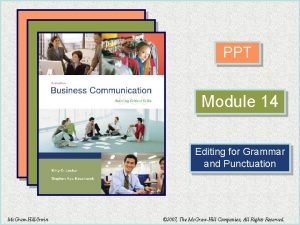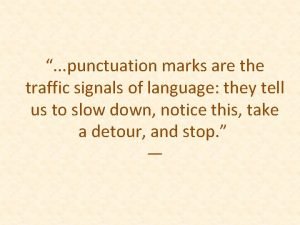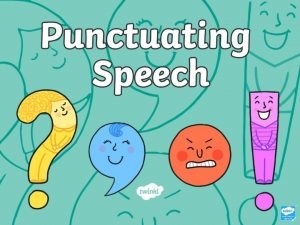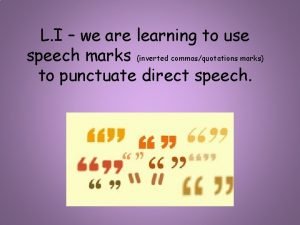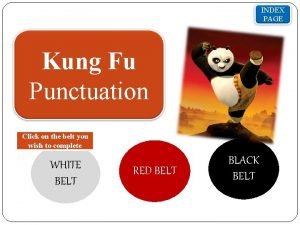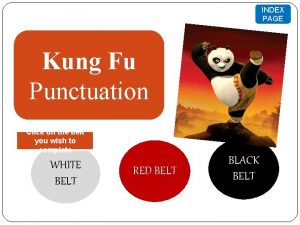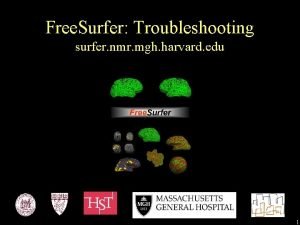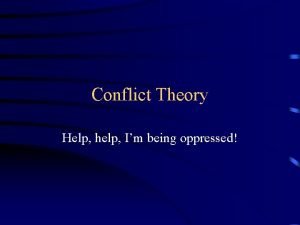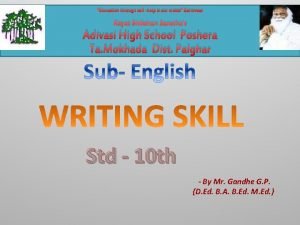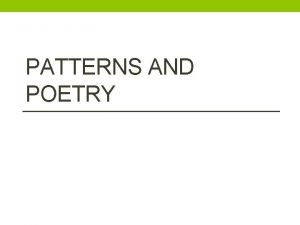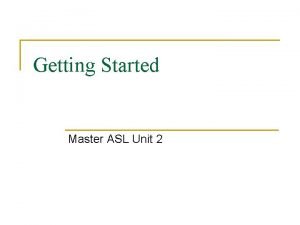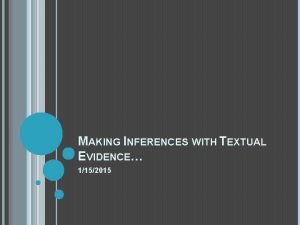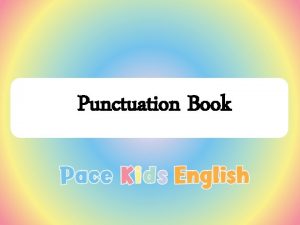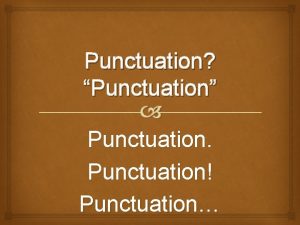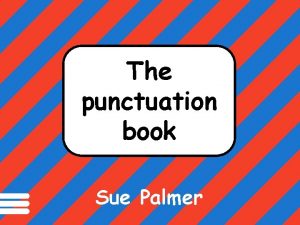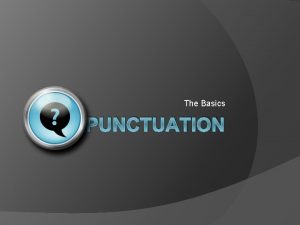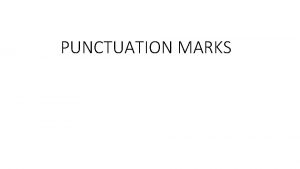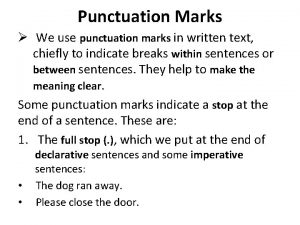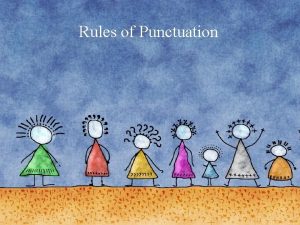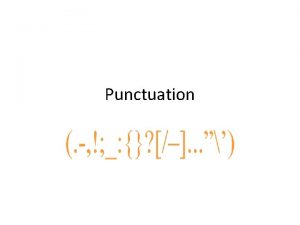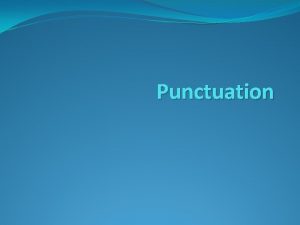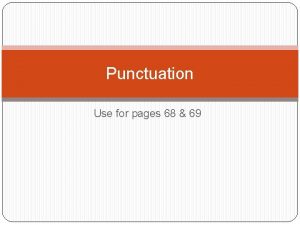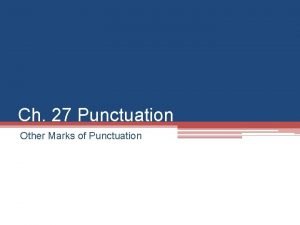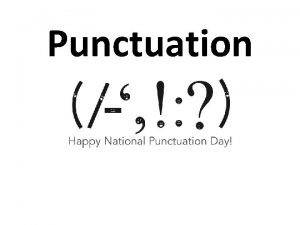Punctuation marks help make meaning clear in The
















- Slides: 16

Punctuation marks help make meaning clear in The written texts. punctuation book Sue Palmer

Punctuation marks help make meaning clear in written texts. They show the reader: * where one chunk of meaning ends and another begins * where to pause or change tone when reading aloud.

full stop shows the end of a statement A sentence * starts with a capital letter * ends with a. * makes complete sense. question mark shows the end of a question ? See also The Sentence Book The Complex Sentence Book Previous slide Three punctuation marks can show the end of a sentence. ! exclamation mark shows * raised voice * strong feelings * an exclamation

separating the items in a list The comma , I bought eggs, a pint of milk, tea and sugar. separating the direct speech from a reporting clause Within a sentence a comma shows where one chunk of meaning ends and another begins… Anyway, I decided not to go. Three weeks later, James was born. Although she was only three, Gemma knew her tables. The introductory ‘chunk’ could be a word, a phrase or a subordinate clause. If you remove it, the main clause would still make sense. See explanation on direct speech page. marking off extra information embedded in the sentence separating off ‘tag phrases’ and names This is great, isn’t it? How old are you, John? separating off an introductory ‘chunk’ See also comma splice. Jill, my boss, is 28 years old.

Dash A dash gives a break halfway between , and. showing a sharp break between two chunks of meaning Both these chunks are main clauses. A comma cannot separate two main clauses. e. g. It was great to see you _ we must meet again. The dash is a feature of informal writing, which echoes speech patterns. For the formal equivalent, see semicolon. Previous slide marking off extra information embedded in the sentence e. g. On Monday – the first day of our holidays – we explored the beach.

Brackets ( ) Brackets show information which is extra to the main text… marking off extra information embedded in the sentence e. g. On Monday (the first day of our holidays) we explored the beach. As brackets are very noticeable, they are used when the writer wishes to draw attention to the extra information. marking off extra facts like dates or dimensions e. g. Elizabeth I (1553 – 1603) Mount Everest (8850 m) Brackets are sometimes call parentheses. Information in brackets is said to be in parenthesis. Commas and dashes can also enclose parenthetic information.

Semicolon ; A semi-colon gives a break halfway between , and. to separate two main clauses e. g. It was a great pleasure to meet you yesterday; I hope we meet again soon. The semicolon here is like a formal version of the dash. e. g. I surveyed John Street: small, redbrick houses; an ancient church; three brand new bungalows, and a Victorian town house, gone to seed. When semicolons are used in a list, there is usually a comma before the and. Previous slide to separate lengthy items in a list

Colon : A colon marks a break where there is a feeling of balance between the elements on either side: to introduce a list, an example or a quotation e. g. I surveyed John Street: small, redbrick houses; an ancient church; three brand new bungalows, and a Victorian town house, gone to seed. e. g. I love the first lines of ‘Jabberwocky’: “’Twas brillig, and the slithy toves Did gyre and gimble in the wabe…” Previous slide to separate two main clauses, where the second clause expands on or illustrates the first e. g. It was very cold: the temperature was below zero.

Direct Speech comma before the speech marks * Each new speaker on a new line. ““It’s I , ” said Cinderella. late, ” * Speech marks (“ ”) round the direct speech. * Comma between direct speech and reporting clause… The prince smiled answered, , ““Yes, but we have Y all the time in the world. ”” * * …unless there’s a ? or ! * …unless a sentence is interrupted by the reporting clause. Direct speech begins with a capital letter… See also The Sentence Book, pages 8 – 9. Previous slide W time is it? ” ““What ? ” asked I must leave Cinders. ““I before midnight. ”” I you must go, ” said the ““If y prince, , ““you’d better hurry. It’s 5 to 12. ”” I ““Oh O no!” ! ” cried Cinders.

Speech marks to mark the words in direct speech “Hello, ” said the cat. to show that a word is being used ironically or ‘oddly’ Speech marks are also called quotation marks or inverted commas and may be used… There were many ‘experts’ in the audience. to indicate the title of a book, film, etc The book ‘Black Beauty’ was also made into a film. to show a quotation Wordsworth wrote about an ‘inward eye’. to show when you are talking about a word or phrase The word ‘exit’ is the Latin for ‘he goes out’. “” ‘’ Double and single speech marks. Double marks are usually used in handwritten texts. Single marks are often used in printed texts.

Hyphen A hyphen links words or parts of words e. g. when a word is split between two lines of print when they are put together to make a new word e. g. mother-in-law Irish-American co-operation The hyphen differs from the dash in that • you do not leave a space between the words and the hyphen • it is half as long.

Ellipsis … an ellipsis is three dots… to show that a sentence is unfinished e. g. to show that a sentence is… to show that words have been missed out in a quotation e. g. The hyphen differs from the dash in that… it is half as long.

he t f o se ma u s m Mi Co The comma splice Rule of thumb: Gemma was worn out, she curled up on the ground and went to sleep. a comma splice Rule: A comma cannot be used to separate two main clauses. If you could substitute a full stop, a comma is probably wrong. You could use alternative punctuation: Gemma was worn out. She curled up on the ground and went to sleep. (see Sentence) Gemma was worn out-she curled up on the ground and went to sleep. (see Dash) Gemma was worn out; she curled up on the ground and went to sleep. (see Semicolon) Gemma was worn out: she curled up on the ground and went to sleep. (see Colon) or you could add a conjunction, e. g. Gemma was worn out so she curled up on the ground and went to sleep. Previous slide

omission The Apostrophe In shortened forms of words, the apostrophe shows where letters have been missed out. ‘s shows ownership the girl’s coat the coat belonging to the girl cannot should have you are can’t should’ve you’re it is it’s I will I’ll possession does not doesn’t the children’s home the home belonging to the children If the owner-noun is a plural ending in s, just add ‘ the girls’ coats the coats belonging to the girls the princesses’ hats the hats belonging to the princesses

Other devices for helping make written language easy to read and understand: * the use of space e. g. paragraphing * organisational devices e. g. bullet points * presentational devices e. g. italic print, bold print, underlining, enlarged print, CAPITAL LETTERS.

Skeleton Poster Books for GRAMMAR The End Show
 Punctuation marks make meaning clear.
Punctuation marks make meaning clear. 14 punctuation marks ppt
14 punctuation marks ppt How to use punctuation in quotes
How to use punctuation in quotes Punctuation marks are like traffic signs. this sentence is
Punctuation marks are like traffic signs. this sentence is Put the correct punctuation marks in these sentences
Put the correct punctuation marks in these sentences Indirect speech
Indirect speech Put the correct punctuation marks in these sentences
Put the correct punctuation marks in these sentences Kung fu punctuation speech marks
Kung fu punctuation speech marks Punctuation kung fu
Punctuation kung fu Sentences with exclamation mark
Sentences with exclamation mark Help us help you
Help us help you I m being oppressed
I m being oppressed Helper
Helper Self help and community help is the motto of
Self help and community help is the motto of My mother makes me chicken
My mother makes me chicken Easy asl sentences
Easy asl sentences How does textual evidence help a reader make an inference
How does textual evidence help a reader make an inference

